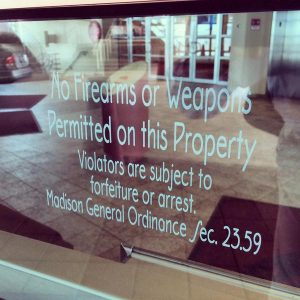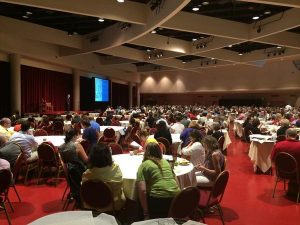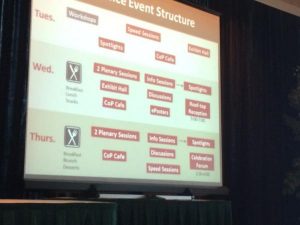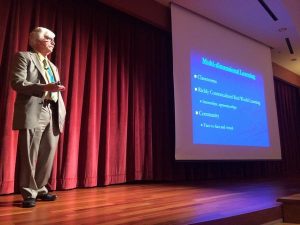[updated 8-19 10:00am]
[updated 8-18 9:00am]
I’ve arrived and settled in at UW’s annual Conference on Distance Teaching and Learning, from today to Thursday (Aug 12-14). I’ve come with a few hats on: at a general level, trying to glean insights into online, distance, and hybrid educational practices and technologies, and more specifically, thinking about current and future directions for the Columbia-Cornell-Yale Shared Course Initiative — supporting faculty in the integration and application of new technologies, learning lessons about the introduction of a new Learning Management System (Canvas, in our case), thinking about strategies for teachers conducting synchronous and asynchronous pair and group work online, and then an interest in questions of community-building and common space-formation in classrooms across the three schools. I arrived on the plane reading Communities of Play by Celia Pearce and Artemesia (MIT Press, 2009), and have been excited like millions of others about ideas of gamification and simulation in higher ed contexts. And in terms of people and programs, I’m hoping that I’ll be able to connect with people involved in the Committee on Institutional Cooperation’s CourseShare project. Oh and then, they say there’s something about the cheese here in Madison too…
Below I’ll chronicle some of the conference goings-on that I’m able to catch. With 800 participants and just 2 1/2 days, this conference generally has 8 different things going on at once, in at least 4 different formats, which is great for inviting more active participation from attendees, but can be hard to get a grip on.
Day 1 (Tues.)
I started off at a session about the conference itself. Like any conference with a 30-year history in the same location, there was a lot of self-referentiality going on, and it was obviously a reunion for many people at UW and in the area who have seen each other for years or decades. I didn’t go to them generally, but sessions like Curt Bonk’s “How Charles Wedemeyer opened our world and changed my life” seemed to speak to this. A useful aspect of the orientation was the introduction to the Twitter hashtag #UWdtl14 and a few fellow tweeters; it was amusing to see the high place given to food in the organizational scheme of things.
My first session got to some of the gaming questions. Dan Norton of Madison’s Filament Games made some observations about evaluating educational games; his point that educational games shouldn’t shirk their educational goals and in fact have to foreground these to succeed, repeated often by others, was a welcome antidote to the urge to use the allure of colorful graphics and characters as the “chocolate coating on broccoli.” He argued that simulation is at the heart of all games, but that a meaningful distinction could be drawn between those that rewarded global goal achievement (like Sim City) and those that rewarded role and character development (like a flight simulator). Of course, many games do both, but he suggested that making these kinds of distinctions would help educators to see just how learners could use games to understand the function of complex systems (and their own role within them), through their immersive engagement (play).
- Sites to check out from his talk: BrainPOP, Aris Games
The second Tuesday afternoon session, “Faculty engagement strategies,” was by Karen Skibba, an instructional designer at UW-Madison. Her agenda was broad, as she looked at the divergence between designers’ ideals and hopes for faculty and faculty’s actual motivations for learning to use new technologies. Her lists of intrinsic and extrinsic attractors and motivators got my attention:
Intrinsic factors: engaging students, enhancing learning, teaching satisfaction, reducing workload, reducing uncertainty, reaching new audiences, developing new ideas, sharing ideas with others
Extrinsic factors (useful in the beginning for the “early majority” of adopters, she said, but obviously not sustainable in the long run): support, stipends, release time, research opportunities, resources, student assistance, recognition
She emphasized the very pragmatic desires and needs of faculty: support for technology adoption needs to be flexible, available, and timed well to periods of need. Among the different means of offering support she listed:
step-by-step guides, online tutorials, faculty real practice examples, brown bags, road shows, short webinars, micro workshops (on a single topic or issue), online and F2F workshops, semester learning communities, year-long learning communities, grant programs, research (SoTL)
- Other resources to follow up on: Nancy Chism’s 2004 article, “Using a framework to engage faculty in instructional technologies,” the funny/depressing/pragmatic “5-minute university,” a video parody of learners’ actual retention of what they’ve studied
Day 2 (Weds.)
Today was the fullest day of events, starting with the official conference welcome and 8am (ouch) keynote by Michael Quinn Patton, longtime faculty with the University of Minnesota and currently consultant on organizational development and program evaluation. His title “Evaluation for innovative change,” and his recent work (see this overview of qualitative evaluation for example) reflect the broad applicability of his interests. The main take-aways for me were the need for a focus on user/learner/faculty uptake and not just ‘delivery’ of knowledge or resources (types of programmatic ‘innovations,’ ‘developments,’ or ‘innovations’), and the embedding of robust evaluative tools and techniques into the fabric of technological and pedagogical design innovations of all kinds, from the very get-go. His point that mid-term and final evaluations in all kinds of endeavors can easily fail to capture information about learning at the time it is taking place most richly–near the beginning.
- Sites to check out from his talk: Fail Forward: an organization hosting dialogue, sharing resources, and holding a conference seeking to capitalize on “intelligent failure”
I didn’t catch much of the second speaker to address the entire conference, a virtual guest speaker whose audio feed was sent around many of the common spaces but whose visual (Skype) feed was only visible in the bustling exhibit hall space. Elliott Masie, apparently one of the first to popularize the term “eLearning” and now a leader of his own think tank, painted a picture of an increasingly modular, interruptible, even distraction-filled online learning environment as the norm to which educators and educational designers must acclimate themselves. His warning/dictum to those assembled, “The learner of the future is not our prisoner,” sticks in my mind. What are the implications of that statement for teachers?
- Reminders to check up on: Other big ‘e-prophets’ like Henry Jenkins, Howard Rheingold, Sherry Turkle…
For the last 2 hours of the morning, I attended 2 discussion sessions, the first led by Camille Dickson-Deane and Joni Moore on analyzing CMSs for their online learning outcomes, and the second by Penny Ralston-Berg and Eric Bauman on the fit between games and simulations for curricula in various kinds of school settings. While in the first session some of the differences between purely online courses and shared courses like those of the Columbia-Cornell-Yale SCI became clear as they pertain to CMS/LMS design–for instance, instructions and learners’ navigational paths must be made transparent in solely online contexts because learners don’t have the benefit of physically copresent instructors and peers to explain and disambiguate any areas of confusion–the need for transparency of goals, expectations and procedures in all course materials and supporting technologies was abundantly clear. And I found the discussion session on games and simulations to be useful as well, even if the immediate context was hands-on, real-world nursing and healthcare education (see Bauman’s book) and not more disembodied or abstract knowledge. The use of games and simulations makes even more pressing the need to tap into learners’ intrinsic motivation, making classroom activities seem as real and necessary to learners as possible. In the case of the Less Commonly Taught Languages of the Shared Course Initiative, for instance, this underlines the desirability of making the classroom technologies (the LMS, for instance) facilitate the exposure to and use of the target language and culture.
Bill Draves’ talk at 2pm, “Generational Learning Styles in the Online Classroom,” was probably the highlight of the day for me. His presentation was ostensibly a review of the traits of Baby Boomers, Gen X, and Gen Y as they pertain to their respective expectations and use of contemporary communications technologies; what it ended up being was more of a ‘reality check’ for the Boomers with respect to the online habits of Gen Y [note: I had to bone up on the respective definitions of these terms and found this Telegraph article quite helpful and amusing]. Whereas the Boomers (he says) grew up in the “factory age” and view people’s time invested in a certain activity as directly correlated with productivity and learning, Gen X and Y tend not to view time as so linear, are more outcomes- and not so process-oriented, and want instant feedback on their work. Key facets of the online culture of Gen Y (who are, he said, “dominating culture and economics now,” and “will dominate the workplace and higher education by 2020”) include:
- Online course quality not nearly good enough
- Value F2F too. both/and not either/or
- Need very clear instructions
- Need you to help identify critical data and information, eliminate all else
- Learn with multimedia. Require multimedia
- Learn by creating content
He concluded with some words of wisdom for the Boomers in the audience (it seemed to me that the majority of conference attendees seemed to belong to this category): “Your role as a teacher is totally opposite of what it was 20 years ago.” Before, the job of the teacher was to transmit information to students; now it’s to help students narrow things down, to relate important things to each other, and eliminate irrelevant or low-quality information in an age of information excess. If you’re a boomer teacher, he said, “don’t worry about Gen Y. It’s a sign of disagreement and/or disrespect. Your ‘worry’ means you’ don’t understand the rationale behind Gen Y behavior.” And, he said, underlining the need of Gen Y students for videos, images, and other multimedia in order to learn, “Do multimedia. It’s not hard.”
- Websites mentioned by Bauman and Ralston-Berg: thiagi.com
Day 3 (Thurs.)
Although I went to a session from 10-11am on practical applications of evidence-based research featuring Allan Jeong (FSU), Janet Zadina (Tulane), and Michael Simonson (Nova Southeastern U), and later after a brunch to a general overview session on emerging trends in mobile learning technologies with Rovy Branon of UW Extension, the most provocative of the day for me was Chris Dede (Harvard U)’s presentation, “Massive Immersive Learning: A New Dimension for Higher Education.” His basic contention was that while a lot of educators and their instructional technologies are aimed at enriching students’ classroom and community-based learning experiences, there is a need to focus on the internship or apprenticeship stages of learning (the stage, he said, between classroom and community). And in the line of some of the other sessions I had followed that focused on simulations and gaming structures in online learning environments, the way to do this was within a 3-D, immersive learning environment developed with his colleagues, designed to involve students in exploration and problem-solving from a first-person perspective. This is also a scalable social environment, where peer feedback and reflections on one’s own decisions and pathways draw on students’ own experiences and personal investment such that they can develop “advanced” cognitive, interpersonal, and interpersonal skills (what he termed multi-dimensional learning).
Here I’m really just trying to drop as many keywords that will help me and anyone else interested in exploring this further to have starting points for conversation. He referred several times to his recent co-authored report, “New Technology-Based Models for Postsecondary Learning: Conceptual Framework and Research Agenda,” and mentioned the January 2009 issue of Science (special issue on Education & Technology) as important in understanding different kinds of immersion. His project seems to hold potential for educators looking to increase the depth of students’ applied online learning experiences, while also potentially multiplying their breadth.
Yet at the end of his talk, when he didn’t seem to have a direct answer to audience members’ questions about the desirability of immersing massive numbers of students into the same (culturally valenced, limited, predetermined) virtual world for their online apprenticing—and while he didn’t really respond to the question of Harvard’s privileged position in funding, designing, and developing this kind of virtual tool for learning—I wondered just how deep this immersion goes. Dede’s remark in the Q&A period stuck with me: while you can scale some instructional resources on the cheap, the same cannot be said for instructional presence in online, especially massive environments: “instructional presence is expensive.” And, at the end of the day, even as instructional presence is being virtualized and distributed in systems and through media in ways that even masterful teachers and instructional technologists only partially understand, this was one of the central lessons of my Madison experience: instructional presence matters, and it isn’t cheap.
……
For more views and resources from the conference, see the 30th Annual Distance Teaching & Learning conference Storify.
Some general EdTech sites referenced by a number of people in the conference:
……
 On a final, more personal note, it was hard for me to ignore the news unfolding from Ferguson, MO as this conference went on its way. Not-so-subtle reminders of the pervasive presence of weapons in our midst, even on the doors of the venue (Monona Terrace convention center), seemed to me to leave an uncomfortable silence around the event’s enthusiasm for the tools, technologies, practices, and realities of teaching and learning at a distance in the United States today. (Wisconsin, I later learned, became the 49th state to allow the concealed carry of weapons in 2011). I do hope that discussions of the social, economic, racial, and linguistic (this list could go on) inequities that beleaguer schools and communities in the U.S., with their widely varying levels of access to and support for learning technologies, will play a larger part in future conferences like this one.
On a final, more personal note, it was hard for me to ignore the news unfolding from Ferguson, MO as this conference went on its way. Not-so-subtle reminders of the pervasive presence of weapons in our midst, even on the doors of the venue (Monona Terrace convention center), seemed to me to leave an uncomfortable silence around the event’s enthusiasm for the tools, technologies, practices, and realities of teaching and learning at a distance in the United States today. (Wisconsin, I later learned, became the 49th state to allow the concealed carry of weapons in 2011). I do hope that discussions of the social, economic, racial, and linguistic (this list could go on) inequities that beleaguer schools and communities in the U.S., with their widely varying levels of access to and support for learning technologies, will play a larger part in future conferences like this one.




0 comments for “Notes on distance teaching and learning from UW-Madison”